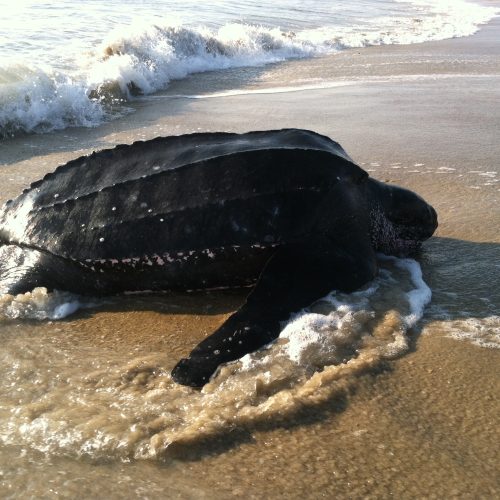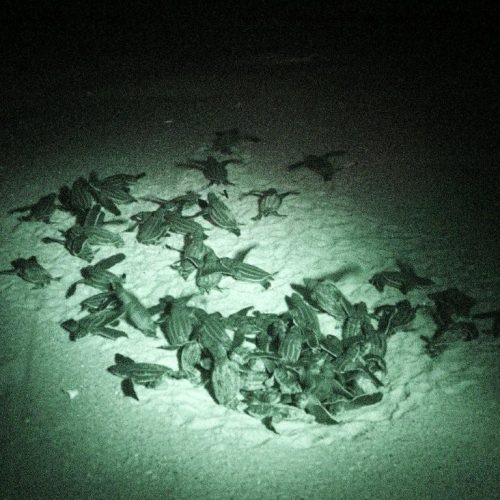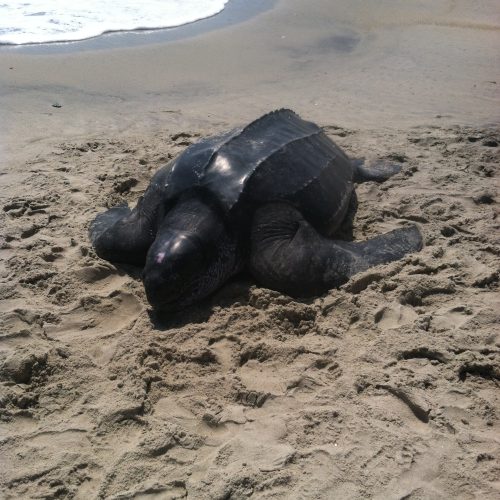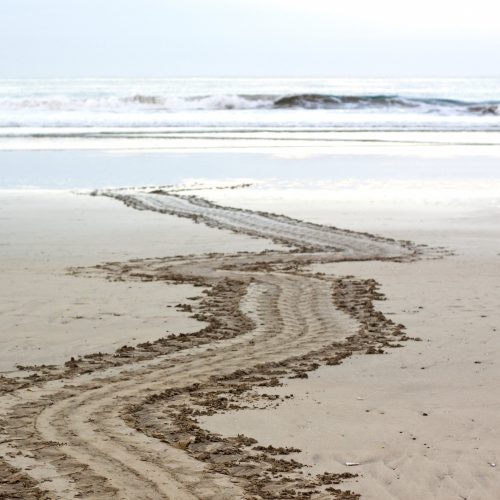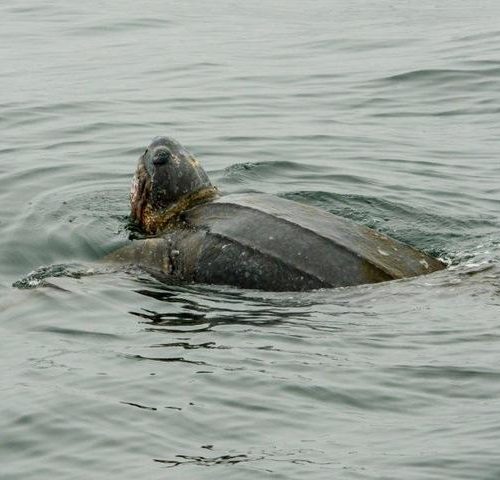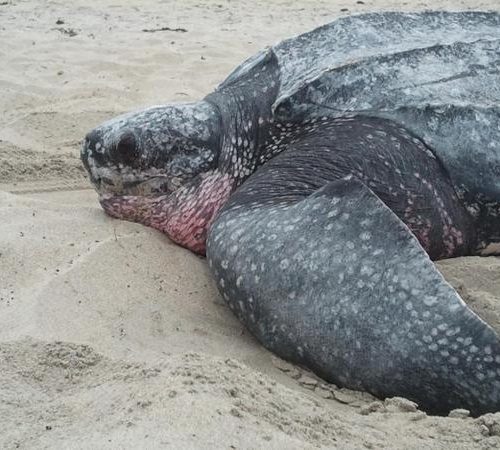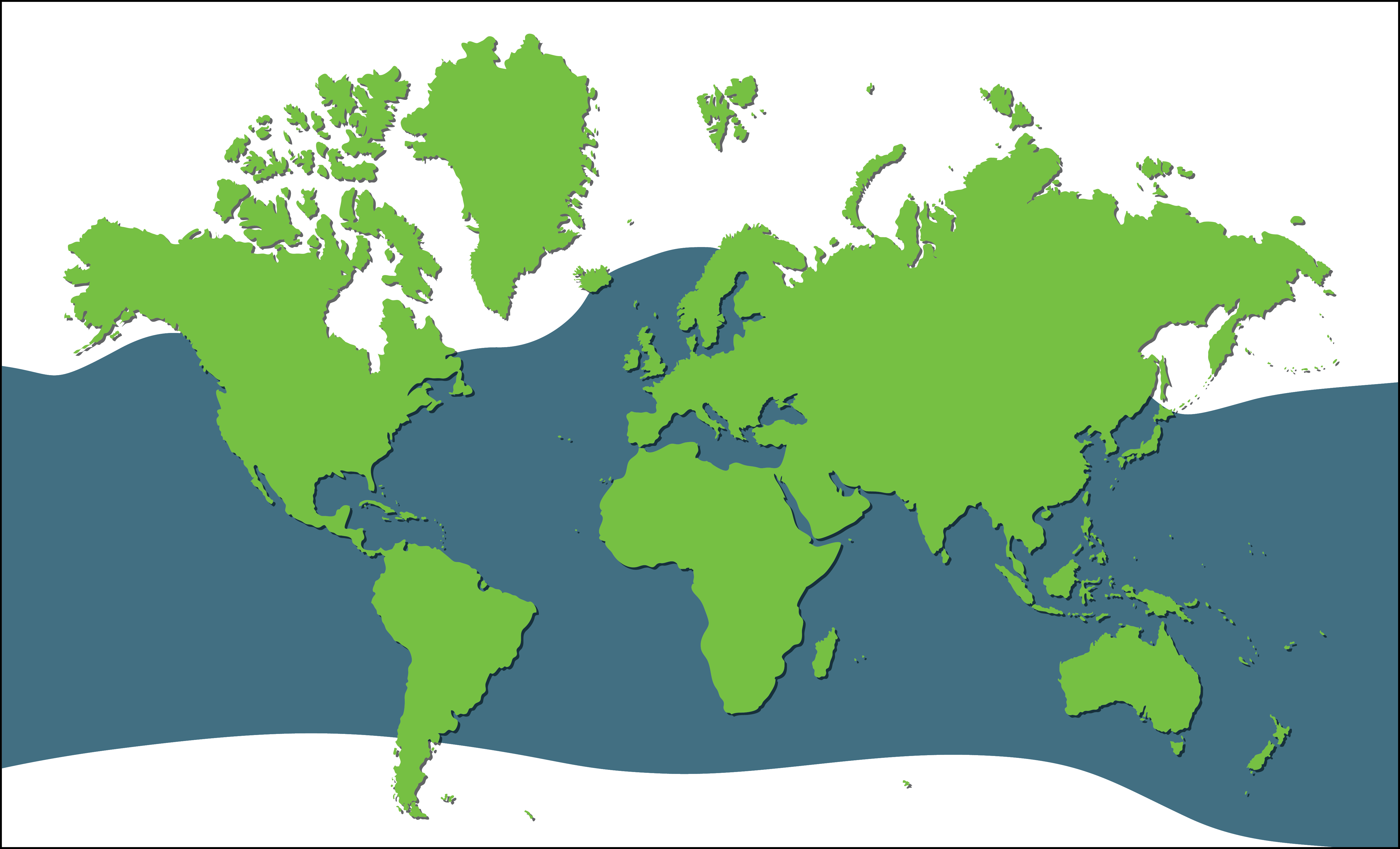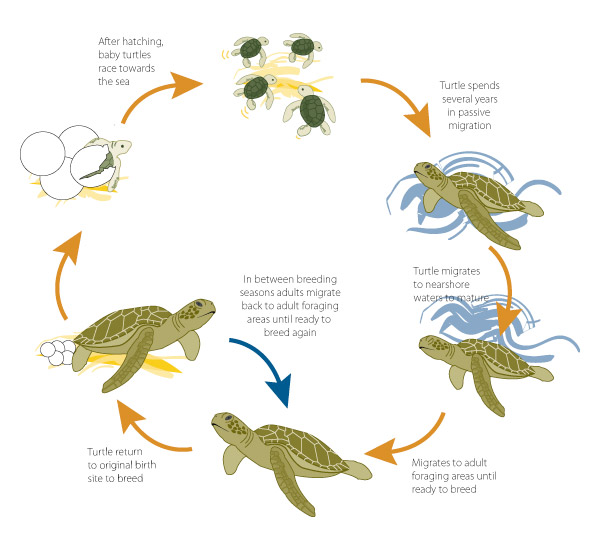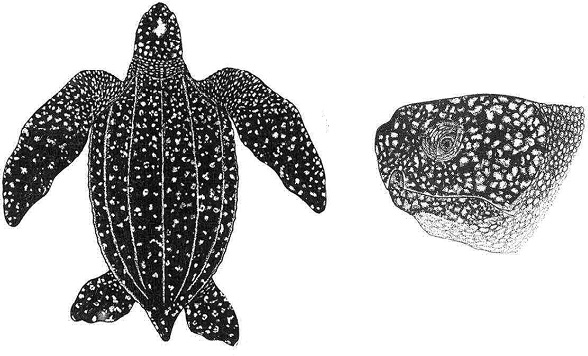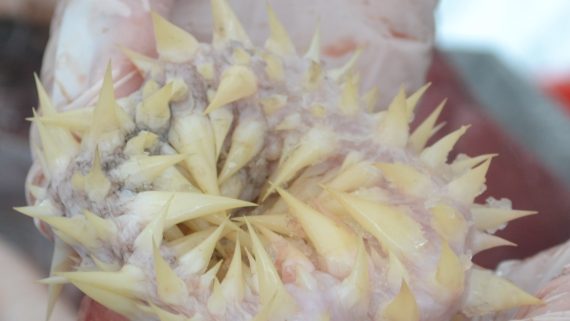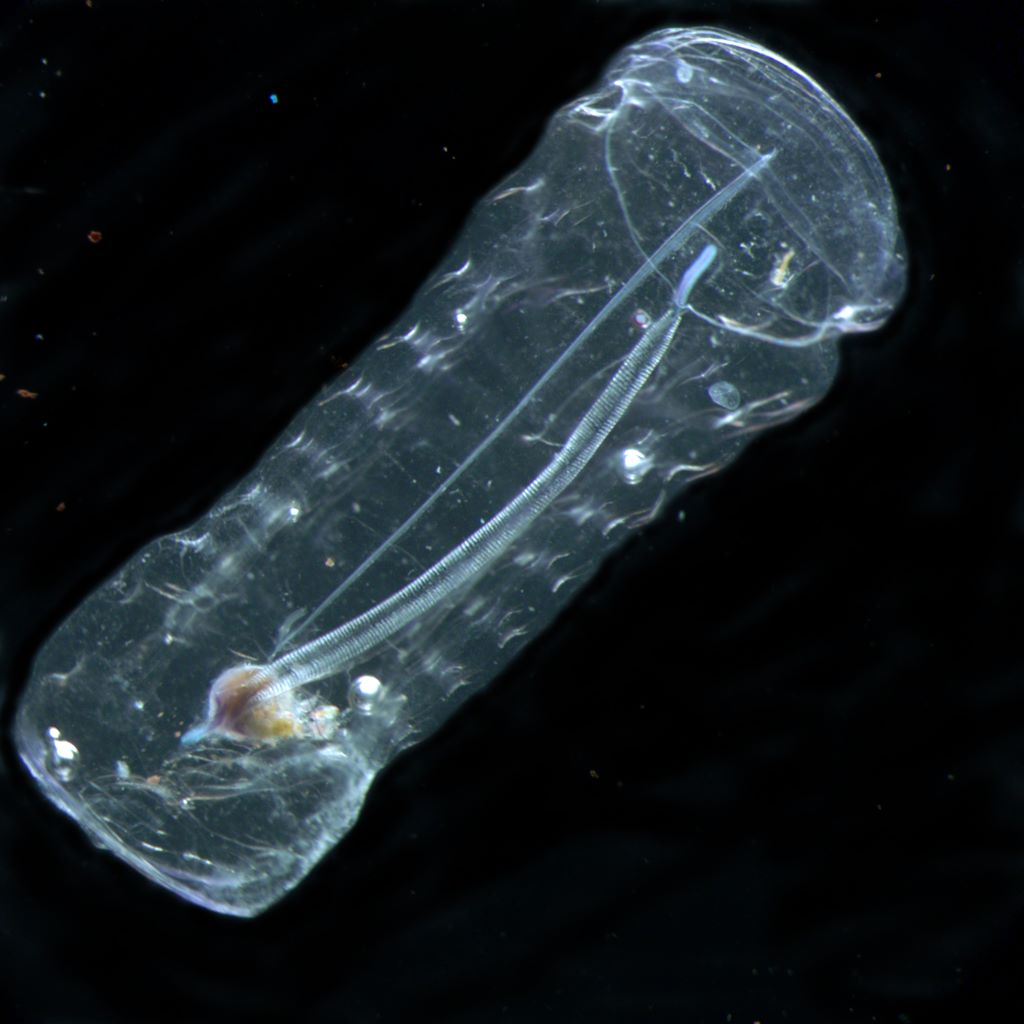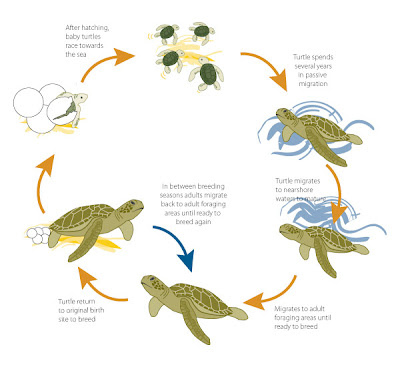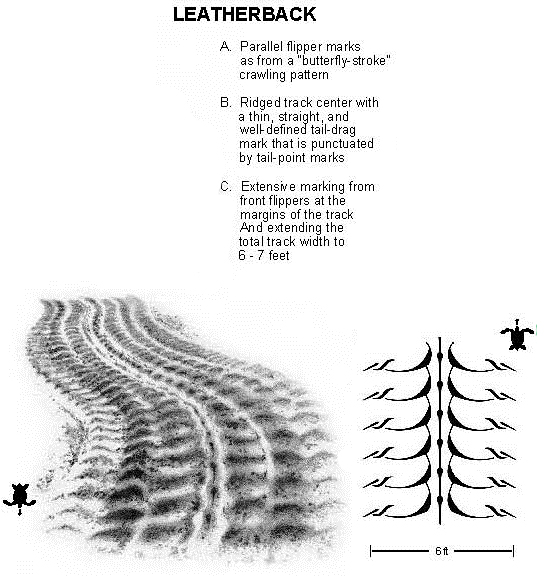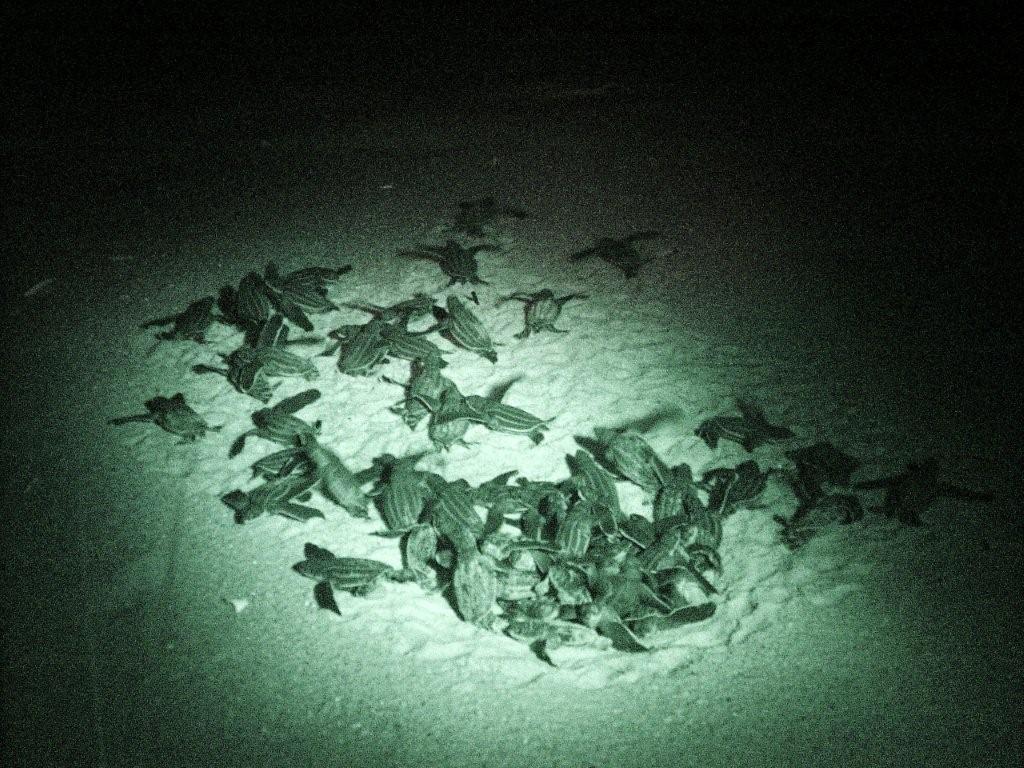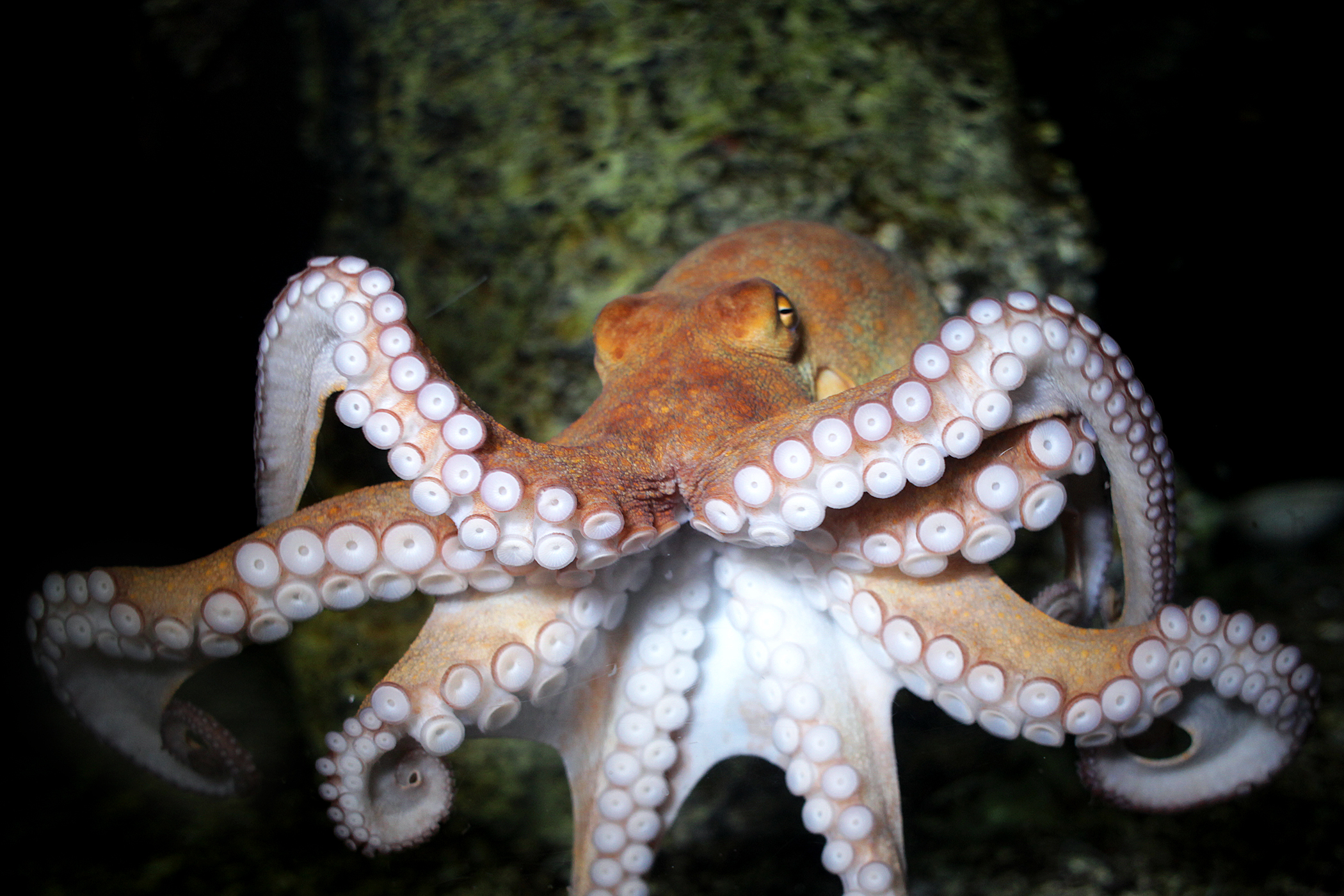Leatherback Sea Turtle (Dermochelys coriacea)
Click here for more detailed information.
Scientific Classification
Class: Reptilia
Order: Testuidae
Family: Cheloniidae
Genus: Dermochelys
Species: coriacea
Species Description
Largest species of sea turtle
Carapace: Elongated; Skin covered; Black with pale spots; Has seven distinct ridges
Typical Adult:
Weight: 550-700 lb (250-320 kg)
Length: 72-78 in (180-200 cm)

Conservation
Status
Endangered throughout its range
Threats
- Hunting
- Interactions with fishing gear
- Habitat destruction
- Pollution
- Climate change
- Lack of information

Life History
Reproduction - Seasonal
Sexual maturity: 5-21 years
Breeding: February to July in the US
Average clutch size: 100 eggs
Average clutches per season: 4-7 (up to 9)
Renesting interval: 8-12 days
Range of nest incubation: 60-75 days
Lifespan
Unknown

- Leatherback hatchlings grow faster than any other reptile. They reach adult size (over 550 lbs) in just 7-13 years.
- Leatherbacks can swim up to 22 miles per hour.
- Leatherbacks have specific adaptations that allow them to live in colder water than any other sea turtle.
Description
The leatherback sea turtle is the largest sea turtle. The largest turtle on record measured almost 7 feet (2.1 m) in length. The leatherback does not have a solid, external bony shell like all of the other sea turtles. Rather, it has a loose bony structure covered by dark brown or black rubbery skin. This shell is about an inch and a half thick. The carapace has seven pronounced ridges that run from front to back. The lighter colored plastron has five ridges. Neither the front or back flippers have claws or scales. The flippers are longer relative to their body than those of other sea turtles. Hatchlings are heart-shaped and have white striping along the ridges of their backs and on the margins of the flippers.
This species has unique adaptations – even for sea turtles. Several adaptations make it possible for them to live in colder water than other sea turtle species. They have a network of blood vessels that work as a heat exchanger and a thick insulating layer of oils and fats in their skin. This, and their large size, makes it possible to maintain body temperatures that are much higher than the surrounding environment (Spotila, 2004). Other adaptations help leatherback turtles eat soft, gelatinous food like jellyfish. Pointed cusps and sharp-edged jaws act like teeth while backwards pointed papillae cover the throat, keeping the food headed towards the stomach and protecting the turtle from jellyfish stings.
Distribution
The leatherback is the most wide-ranging of the sea turtles. They have a nearly worldwide distribution and travel long distances from their nesting beaches to their feeding grounds. They are mainly found in warm tropical waters. However, larger adults (those more than three feet in length) can also be found in colder water. These bigger turtles can be found far north as the cold subartic waters of Newfoundland, Nova Scotia and Labrador. They can also be found in the cold waters of southern Argentina and South Africa. Smaller animals are almost always found in warmer tropical waters.
Leatherback turtle nesting grounds are also located around the world, mostly on tropical beaches. The largest remaining nesting areas are found on the coasts of northern South America and West Africa. Within the U.S., there are small nesting colonies in the Caribbean and in southeast Florida.
Habitat
Leatherbacks use three different ecosystems during their lives:
- Sandy beaches
- Open ocean
- Coastal waters
They spend most of their time in open ocean throughout the world. They are deep divers and have been found at depths of over 4000 ft (1219 m). They can also be seen feeding in coastal waters. Breeding females nest on narrow tropical sandy beaches backed with vegetation.
Diet
Leatherbacks are primarily carnivorous. They eat soft-bodied prey found in the open ocean such as jellyfish and other invertebrates without shells. They will occasionally eat algae and seaweed.
Life History
Leatherbacks spend most of their lives in the open ocean. Little is known about the life history of hatchling to juvenile leatherbacks. Adult females only come ashore to nest. Males usually don’t come ashore at all. The life span of the leatherback is unknown but believed to be approximately 50 years in the wild.
Leatherbacks are thought to reach sexual maturity in about 16 years. However, as with many reptiles, size is a more reliable indicator of sexual maturity than age. Leatherbacks migrate to areas just offshore of common nesting beaches. They mate in these areas and as they travel to them. Males tend to return to locations where they have mated successfully in previous seasons.
Leatherback females don’t always return to the same beaches, but do nest in the same general area. Females only nest once every two to three years and only during a specific time of year. Along the North American east coast, nesting occurs from March to July. When a female is ready to lay her eggs, she swims up to the nesting beaches at night. She then crawls up the beach until she is above the high tide line and digs an egg chamber with her back flippers. She deposits about 100 eggs into the egg chamber. About 30% of these eggs will be infertile. She then covers the nest with sand, disturbs a large area around the nest and returns to the ocean. Like other sea turtles, she leaves behind a distinctive, species-specific crawl pattern.
The female will repeat this pattern (renest) an average of four to seven times over the season, returning to the beach every 12 days. When a female is finished nesting, she will migrate from tropical to cooler waters. These cooler waters support high densities of her primary food – the jellyfish.
The eggs incubate from 60 to 75 days. Environmental temperature is very important to developing eggs. The speed of development within the egg (length of incubation) depends on the temperature in the nest. This temperature can be affected by sun, shade, rain, heat generated within the nest, and an egg’s position in the nest. Warmer nests hatch more quickly.
Like most reptiles, the sex of the turtle is also determined by the temperature of the nest during the middle third of incubation. This is called temperature dependent sex determination, or TSD.
Leatherback hatchlings usually emerge from the nest at night. Once on the surface they quickly orient and move towards the ocean. They use moonlight reflected from the surface of the water as a guide.
Threats
Leatherback turtles face threats both on nesting beaches and in the ocean. The greatest causes of population decline and the primary threats to leatherbacks worldwide are long-term harvest by people and incidental capture in fishing gear.
Sea turtles face different predators as they age.
Eggs and hatchlings are the most vulnerable. They may be eaten by a wide range of coastal predators, such as crabs, large lizards, small mammals (e.g. raccoons, coatis, dogs, coyotes, etc.) and a variety of birds of prey and shorebirds.
Once in the ocean, young leatherbacks still face predation from cephalopods, sharks and other large fish.
Adult leatherbacks are occasionally preyed upon by large marine predators such as orcas, great white sharks and tiger sharks. However, adult leatherbacks have been observed aggressively defending themselves from predators at sea.
Nesting females are also attacked by feral dogs, large predators, biting flies and humans.
Hunting. Historically, a principal cause of decline in the Leatherback sea turtle population was long-term harvest. Unfortunately, sea turtles are still hunted. Eggs and adults are harvested on nesting beaches, while juveniles and adults are harvested on feeding grounds. Although this practice is less common now, it still occurs in many areas around the world.
Commercial Fishing. Accidental capture in fishing gear is a serious ongoing cause of death that also negatively affects the population.
Pollution:
Trash. Turtles eat a wide array of the 24,000 metric tons of floating trash dumped in the ocean each year. This includes such items as bags, sheets, pellets, balloons and abandoned fishing line. Sea turtles may mistake the floating plastic for jellyfish, a common food item. When turtles eat plastic, it causes many health concerns, including blocked intestines, malnutrition, suffocation, ulcers and starvation. Ingested plastics also release toxins that accumulate in the turtles tissues. These toxins lead to thinner eggshells, tissue damage and unusual behavior.
Artificial lighting. Artificial light impacts nesting females and hatchlings. Females appear to prefer nesting on beaches free of artificial lighting or shadowed. Hatchlings automatically move towards the ocean using reflected moonlight or starlight on the water as a guide. Artificial light is brighter and can confuse them so they navigate inland towards that light and away from the ocean. This results in dehydration and predation. Artificial lighting causes tens of thousands of hatchling deaths per year.
Climate Change. Changes in global temperatures can affect the turtles in many ways.
- Since the sex of sea turtle hatchlings depends on the temperature at which the eggs were incubated, high sand temperatures may change sex ratios resulting in too few males to sustain the population.
- As water levels rise, a number of good nesting beaches will be lost.
- The areas where sea turtles feed may be dramatically altered by climate change.
Click here for more information on the impact of climate change on sea turtle populations.
Habitat Destruction. Habitat destruction and intrusion on the habitat by humans is a serious threat to sea turtles. Beach development for people deprives the turtles of good nesting areas, forcing them to leave or nest closer to the water.
Growth of cities often leads to the siltation of sandy beaches and the construction of docks and marinas can destroy near-shore habitats. Boat traffic and dredging damages habitat and can also injure or kill turtles when boats collide with turtles at or near the surface.
Our lack of knowledge about the population and life history of leatherback sea turtles makes it very difficult to understand what this species needs to survive and thrive.
Conservation
All over the world sea turtle populations continue to decline. Their conservation and recovery requires international cooperation in order to address all of the threats to these species. The Leatherback is considered to be endangered throughout its range.
In the U.S., the National Oceanic and Atmospheric Administration (NOAA) Fisheries and the U.S. Fish and Wildlife Service (USFWS) protect sea turtles. NOAA monitors the turtles while they are in the ocean and USFWS while they are on land. Federal and state agencies have developed regulations to eliminate or reduce threats to sea turtles. For example, NOAA works closely with the shrimp trawl fishing industry to develop turtle excluder devices (TEDs) and reduce the death of sea turtles accidentally caught in shrimp trawl gear. TEDs that are large enough to exclude even the largest sea turtles are now required in shrimp trawl nets. The USFWS, in partnership with other organizations, provides protection for sea turtles and their nests during the nesting season.
You can help too. In many places, workers and volunteers from many different organizations help protect the turtles during the nesting season. Volunteers help locate and protect nests, relocate nests threatened by disturbance or guide hatchlings to the ocean. Even after the eggs hatch, these volunteers can assist scientists as they uncover and count eggs and hatchlings left in the nest.
There are many other ways that we can help as well:
- Limit our use of plastics
- Refuse, Reduce, Reuse, Recycle (see Womble’s Tale)
- Use only turtle friendly products
- Respect sea turtles beaches and nests
- Support sea turtle research
- Volunteer with a recommended sea turtle conservation organization
- Support your local sea turtle conservation organizations
Beacham, W., F. Castronova, S. Sessine. 2000. Beacham’s Guide to the Endangered Species of North Ameica, volume 1: Mammals, Birds, Reptiles. Detroit: Gale Virtual Reference Library. Accessed July 15, 2014 at http:// www. gale. com/eBooks.
Carr, A. 1952. Handbook of Turtles. Ithaca, NY: Comstock Publishing Associates.
Sea Turtle Conservancy. Species Fact Sheet: Leatherback Sea Turtle (Online). Accessed March 30, 2012.
Spotila, James R. (2004). Sea Turtles: A Complete Guide to their Biology, Behavior, and Conservation. Baltimore, Maryland: Johns Hopkins University Press and Oakwood Arts. ISBN 0-8018-8007-6.


